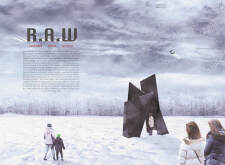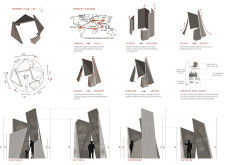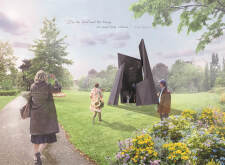5 key facts about this project
The memorial is characterized by its innovative use of materials and geometric configurations. The primary materials utilized are prefabricated concrete and metallic elements, chosen for their structural integrity and aesthetic quality. The concrete is shaped into triangular forms and smooth cladding surfaces, which create a visually dynamic environment. The metallic panels add a reflective quality that engages with light, creating a transformative experience as visitors traverse the space.
Unique Geometric Configurations
A key aspect of the R.A.W memorial's design is its unique geometric configurations. Rather than using conventional linear arrangements, the architect employed shattered triangular forms that symbolize the broken narratives of genocide victims. Each triangular facet functions not only as a structural element but also as a storytelling surface, allowing narratives and inscriptions to be integrated into the design. This method allows the project to transcend typical memorial designs by transforming abstract shapes into meaningful symbols of resilience and loss.
The inclusion of curvature in the design contributes a significant aesthetic and emotional dimension. Curved elements are strategically placed to represent a journey towards healing and liberation, offering a visual contrast to the starkness often associated with memorials. This design approach enhances visitor engagement by guiding them through a path of remembrance, encouraging exploration and interaction not just with the structure, but with the stories it embodies.
Architectural Interaction and Engagement
The architectural design of the R.A.W memorial emphasizes engagement through interactive elements. The narrative panels, integrated throughout the structure, facilitate varying depths of understanding according to the audience's background. This thoughtful design allows individuals of all ages to connect with the history being commemorated, making the memorial both an educational facility and a contemplative space.
Integration with Nature is also a crucial aspect, as the memorial is situated within a broader green landscape. This positioning invites community interaction and highlights the continuity of life in proximity to the solemnity of the memorial. The relationship between constructed space and natural context provides an added layer of meaning, representing the resilience of humanity amidst past atrocities.
For additional insights into the R.A.W memorial, consider exploring the architectural plans, sections, designs, and ideas that further detail its conceptual framework and functional intentions.


























